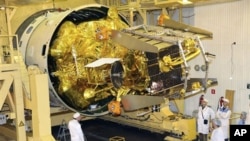The Russian space agency has received word about the first signal from its troubled Mars-bound spacecraft since it became stuck in low Earth orbit shortly after launch two weeks ago.
European Space Agency (ESA) flight technicians at a facility in Perth, Australia detected a signal from the unmanned probe on Wednesday. The ESA and the U.S. space agency, NASA, are helping with efforts to communicate with the spacecraft.
The Russian probe was on a three-year mission to the larger of Mars’ two asteroid-like moons, Phobos. It also is carrying a Chinese satellite that was intended to orbit Mars.
The Russian space agency says it is not likely the spacecraft can go to Mars, but keeping in contact will help engineers understand why it is malfunctioning and hopefully prevent it from crashing back to Earth.
The probe's troubles started about 10 minutes after lifting off from the Baikonur Cosmodrome in Kazakhstan on November 8.
It was to have collected soil from the Martian lunar surface and return the samples to Earth. The spacecraft is called Phobos-Grunt, with Grunt being the Russian word for soil.
The Phobos mission was the Russian space program’s first attempt to reach Mars in 15 years, following an embarrassing series of failed efforts in the 1980s and 1990s.
Currently, only the United States, Japan and the European Space Agency have succeeded in carrying out scientific missions beyond Earth’s moon.
Despite past difficulties with its Mars missions, Russia's space program has scored many major achievements in unmanned and manned spaceflight during its more than 50-year history.
In 1957, the then-Soviet Union became the first country to place a satellite, named Sputnik, in Earth's orbit. In 1959, the unmanned Soviet Luna 3 spacecraft gave mankind its first view of the so-called dark side of the Moon.
Two years later, Soviet cosmonaut Yuri Gagarin became the first human to orbit the Earth.
Russian Soyuz spacecraft are currently the only means to transport personnel, equipment and supplies to and from the International Space Station.
Mars orbits between the Earth and the gas-giant planet, Jupiter. The Martian moon, Phobos, measures about 23 kilometers across. The red planet's other tiny moon, Deimos, is only 13 kilometers wide.
Some information for this report was provided by AP and AFP.









